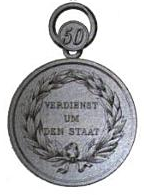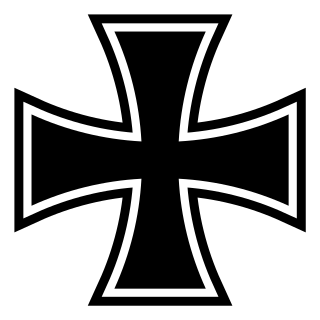
The Iron Cross was a military decoration in the Kingdom of Prussia, and later in the German Empire (1871–1918) and Nazi Germany (1933–1945). The design, a black cross pattée with a white or silver outline, was derived from the insignia of the medieval Teutonic Order and borne by its knights from the 13th century. As well as being a military medal, it has also been used as an emblem by the Prussian Army, the Imperial German Army, and the Reichswehr of the Weimar Republic, while the Balkenkreuz variant was used by the Wehrmacht. The Iron Cross is now the emblem of the Bundeswehr, the modern German armed forces.

The Pour le Mérite, also informally known as the Blue Max, is an order of merit established in 1740 by King Frederick II of Prussia. The Pour le Mérite was awarded as both a military and civil honour and ranked, along with the Order of the Black Eagle, the Order of the Red Eagle and the House Order of Hohenzollern, among the highest orders of merit in the Kingdom of Prussia. The order of merit was the highest royal Prussian order of bravery for officers of all ranks.
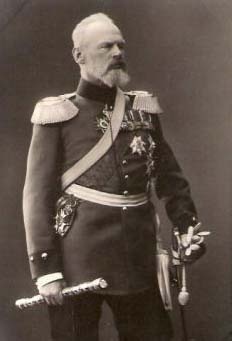
Prince Leopold of Bavaria was born in Munich, the second son of Prince Regent Luitpold of Bavaria (1821–1912) and his wife Archduchess Augusta of Austria (1825–1864). He was a Field Marshal (Generalfeldmarschall) who commanded German and Austro-Hungarian forces on the Eastern Front in World War I.

The Order of the Red Eagle was an order of chivalry of the Kingdom of Prussia. It was awarded to both military personnel and civilians, to recognize valor in combat, excellence in military leadership, long and faithful service to the kingdom, or other achievements. As with most German other European orders, the Order of the Red Eagle could be awarded only to commissioned officers or civilians of approximately equivalent status. However, there was a medal of the order, which could be awarded to non-commissioned officers and enlisted men, lower ranking civil servants and other civilians.

The Military Merit Medal was a military decoration of the Empire of Austria-Hungary. It was founded by Emperor Franz Joseph I on March 12, 1890. The Military Merit Medal is often referred to as the "Signum Laudis" after the inscription on the reverse of the medal.
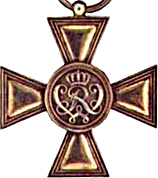
The Military Merit Cross was the highest bravery award of the Kingdom of Prussia for non-commissioned officers and enlisted soldiers. It was also known as the Golden Military Merit Cross to distinguish it from the Military Decoration 1st Class, a lesser Prussian enlisted bravery decoration which was an identical cross but in silver. The Military Merit Cross came to also be known as the "Pour le Mérite for non-commissioned officers and enlisted men", after the Pour le Mérite, Prussia's highest military decoration for officers.
Orders, decorations, and medals of the German Empire covers those decorations awarded by the states which came together under Prussian leadership to form the German Empire in 1871. For convenience's sake, this category also covers the decorations of the various German states which were no longer in existence in 1871, mainly because they had been annexed by Prussia during the Wars of Unification or before.

The House and Merit Order of Duke Peter Frederick Louis or proper German Oldenburg House and Merit Order of Duke Peter Frederick Louis was a civil and military order of the Grand Duchy of Oldenburg, a member state of the German Empire. The order was founded by Grand Duke Augustus of Oldenburg on 27 November 1838, to honor his father, Peter Frederick Louis of Oldenburg. It became obsolete in 1918 after the abdication of the last grand duke.

Felix Ludwig Grafvon Bothmer was a German general from Bavaria. He notably served in the Brusilov offensive of World War I.
The honours system in the Republic of Austria is a means of rewarding individuals' personal achievement, or service to Austria by state decorations and medals.

The Decoration of Honour for Services to the Republic of Austria is a state decoration of the Republic of Austria. It is divided into 15 classes and is the highest award in the Austrian national honours system.

The Red Cross Medal was a German medal set up on 1 October 1898 by Wilhelm II. It had three classes and could be awarded to all those who carried out great service to the sick in peace or wartime, or for special achievement in the service of the German Red Cross. Though service to the sick during times of war had been recognized with prior awards of the Order of the Crown and General Honor Decorations with the Red Geneva Cross, Empress Augusta Victoria the royal patroness of the organization wanted an award to recognize work in peacetime as well.

The German Red Cross Decoration is a decoration founded in 1922, replaced by the Social Welfare Decoration in 1939 and re-founded in its present form on 8 May 1953. It is awarded by the German Red Cross.

The Awards and decorations of the German Armed Forces are decorations awarded by the German Bundeswehr, the German government, and other organizations to the German military and allied forces. Modern era German military awards have been presented since the establishment of the Federal Republic of Germany in 1949.
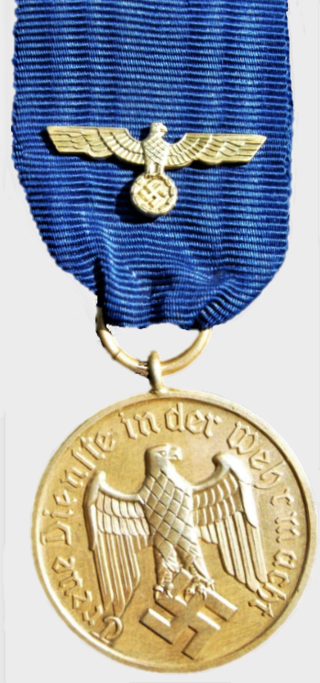
The Wehrmacht Long Service Award was a military service decoration of Nazi Germany issued for satisfactory completion of a number of years in military service.
This is a list of orders, decorations, and medals of Austria-Hungary.

The Merit Cross was a meritorious service decoration of Prussia. Established 27 January 1912, by Wilhelm II in his capacity as King of Prussia, it recognized general merit to Prussia. The cross could be awarded to civilians as well as members of the military. The cross was awarded in two classes a gold cross and a silver cross.

The Military Honor Medal was a two-class military decoration awarded by the Kingdom of Prussia. The medal was awarded to military personnel from the rank of sergeant and below. Established in 1814, it replaced the Gold Military Merit Medal of 1806, with a medal in the shape of a cross silver cross for the 1st class while the Silver Military Medal of 1806 became the 2nd class with minor changes in design.

The House Order of Henry the Lion In German: Hausorden Heinrichs des Löwen, was the House Order of the Duchy of Brunswick. It was instituted by William VIII, Duke of Brunswick on 25 April 1834. The ribbon of the Order was red with yellow edges. It had five grades: Grand Cross, Grand Commander with Sash, Commander, Knight 1st Class, Knight 2nd Class, plus Medal of Merit for Science and Arts, the Cross of Merit and the Medal of Honour. The Order was named in honour of Henry the Lion, who remains a popular figure to this day.
Friedrich Bernhard Karl Gustav Ulrich Erich Graf von der Schulenburg was a Prussian General during World War I and a member of the Nazi Party during the inter-war period.



